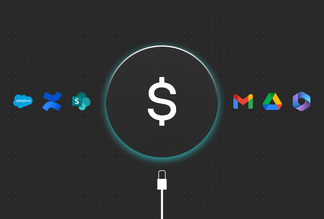

How your best people accidentally build next-gen collaboration tools
If you’ve ever wondered where the product roadmaps of work hubs, collaboration software, and productivity tools come from, look no further than some of your most organized coworkers. The tricks and hacks they implement to optimize communication and collaboration are, unintentionally, the beta tests which often mature into company-wide best practices, which in turn reveal a potential market for features and products.
In short: effective communication is a user experience, and as your best people outgrow your available tools, they piece together better experiences with whatever they can.
Using a handful of examples below, we can illustrate not only how hacks inform the future of business tools, but why it’s crucial for business leaders to be aware of the hacks being used in their own workplace, so that any operational investment in new tools or software actually addresses the current collaboration hurdles.
Search & information recall
Few user tasks, if any, launch more new solutions than the task of searching. Before the days of highly discoverable Slack feeds and Gmail inboxes, searching communications tools was technically feasible, but practically infuriating. One solution to this information recall problem was keyword stuffing, and in fact you’ll still see co-workers practicing it wherever their tools come up short.
Keyword stuffing is simply adding a pile of useful recall terms to a conversation or document, based on an assumption of how you might search for them in the future:
- Find yourself repeatedly hunting down the same slide deck for engineering diagrams? Add an appendix slide stuffed with keywords that provides context to a document otherwise locked out of search due to the visual nature of its content.
- Stuck on an email thread vaguely titled “Re: yesterday,” containing some juicy stakeholder insights about your biggest competitors? Send yourself a reply to that thread with the contents, “CI, competitive intel, competition landscape, Competitor X.”
- Dealing with a spreadsheet full of unstructured data? Add a “Notes” column where you can plug in whatever keywords make the row easier to recall later on.
What’s important to note about the keyword stuffing hack isn’t just that it motivated office products to build smarter, more reliable search features — it also emphasized the need for tagging, labeling, and otherwise classifying content. After all, search and classification have a cyclical relationship.
Most collaboration software worth it's salt these days will have tagging or labeling functions, which serve in part to properly locate and classify content. And because labeling information is how we train machine learning, the humble hack of keyword stuffing lives on as next-gen collaboration tools rely on highly-descriptive labeling to automate processes and anticipate information access.
Meetings
As a black hole of business intelligence and the most expensive part of the workday, meetings have always been a place where high performers employ creative communication hacks.
We all know about the best practice of providing an agenda in the meeting invite (even if few of us ever make the effort to do so). But you’ve probably seen some teammates take it further:
- Providing a shared meeting notes doc where the agenda can be read, where invitees can ask questions, and where action items can be documented and assigned.
- Transcribing the meeting (if allowed) using a machine-reading service, and dumping that transcription into the appropriate destination so any non-attendees can read or search the discussion in the future.
- Enforcing a culture where participants can comfortably leave any meeting once they feel they’re no longer contributing or gaining useful information.
- Prefacing meeting titles with emojis (e.g. ✍, 💲, 📣) so attendees with packed schedules can be better prepared at a glance.
- Offering a simplified or templated response to invitees so that they can do more than just accept or decline the meeting – let them downvote the meeting with an explanation as to why, or suggest that the meeting is blocked by X dependency, or that it should be nixed in favor of an asynchronous update, etc.
It’s rather startling to see just how much ad hoc project management a meeting owner still has to undertake in order to make the best use of their coworkers’ time. But as we see more advanced, next-gen collaboration tools blend communication spaces, progress is being made towards an environment where teammates get just the right amount of exposure to collaborate … where two people can record a synchronous discussion, send the recording out to a third who wasn’t available, and log the transcript for a fourth who only needed to read a bit of context about an action item they were assigned.
Participation & accountability
One of the toughest balancing acts in work is the level of information exposure you give and receive. Too little can confuse or misinform accountabilities, while too much can overwhelm users and hurt effective participation. Many collaboration tools try to aid or automate this balance, and it’s no surprise these advanced capabilities are inspired by the best practices unicorn employees implement manually:
- Maintain a transparent, shareable list of your priorities or workload so stakeholders proposing new work can see what (and who) stands in the way of prioritization.
- Give teammates the lightest obligation possible. Start message threads with an indication of the workload it entails (e.g. Review, Decision, Question, FYI) so they can prioritize their tasks as needed.
- Set reminders or snooze periods on conversations — and communicate them — so your follow-up is timely and nudges don’t come across as surprising.
- Tag coworkers on the specific sections of a task or document where their participation is needed; avoid forcing them to digest extraneous information just because their role is unclear. If tagging isn’t available, bold the coworkers’ names or add an action item section where participants can see what role they’re playing.
- Use work hubs to cross-link and cross-reference information between applications, and ensure some macro layer or master document always serves as the source of truth for work that might be splintered or duplicated across multiple applications.
Notice how many of these tricks don’t simply become individual features of next-gen collaboration tools, but rather that the underlying focus on optimizing exposure drives new user experiences like targeted notifications, activity feeds, and document access history. The continuous optimization of such platforms relies on users to push the current UX to its limits, and then venture forward into experimentation on what a better tool could do. It’s a virtuous cycle, as long as you’re paying attention to it.
Arguably, the greatest takeaway from watching your best employees work around the limitations of their current tools is the gained understanding of what features you should be looking for in next-gen collaboration tools, and where you should expect immediate performance improvements in your org’s communication efficacy once you invest in such tools.
Special thanks to the following experts for contributing some of their best practices to this article: Allison Braund-Harris at Hardly, Hallie Exall at Remote, and Lorraine Lee at Prezi.


